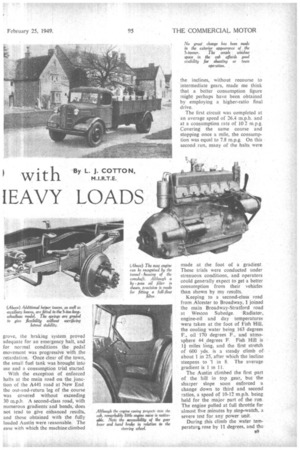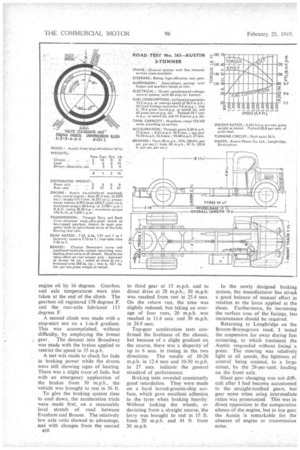SAFE S
Page 16

Page 17

Page 18

If you've noticed an error in this article please click here to report it so we can fix it.
with By L. J. COTTO N, M.I.R.T.E.
LEAVY LOADS
THERE was no reason to doubt the accuracy of the police-car speedometer, when the long arm of the British law was extended to delay my test of the Austin
5-tonner which, it was stated, was being driven at 52 m.p.h. This incident, occurring during the first 10 miles of the trials, although a bad start for the day, was proof that the Austin was not lacking in fleetness or acceleration. Furthermore, I was not, at that time, testing for maximum speed.
The extreme liveliness of the chassis originates from the new Austin six-cylindered overhead-valve petrol engine which, with a 3j'-in. bore and 4k-in. stroke, develops 68 b.h.p. at 2,700 r.p,m. It has a maximum torque of 174 lb.-ft. at 1,000 r.p.m. This new power unit operates with particular smoothness and absence of vibration and, with an eflicient air cleaner-silencer fitted to the carburetter, is notably quiet at all speeds.
It has the conventional one-piece cylinder block and crankcase, with a detachable cylinder head carrying the overhead-valve gear. The forgedsteel camshaft, operating the valves through push-rods and rockers, is carried in four Thinwall bearings and driven from a duplex roller chain, with . a synthetic-rubber tensioner ring fitted to the sprocket to ensure quiet running.
A forged-steel counterbalanced crankshaft is employed and revolves in four bearings of Thinwall pattern. Two compression rings and an oil i8 control ring are fitted to the cast-iron pistons, which are oval-ground.
In the lubrication system, the gearpattern pump forces oil to the main big-end and camshaft bearings, the big-end bearings supplying jet lubrication to the cylinder walls. The camshaft front bearing, together with an oil thrower in the camshaft gear, feeds oil to the timing chain, whilst the valve rocker shaft is supplied from the camshaft centre bearing. A by-pass filter is fitted as standard, but arrangements are made, on the main casting, for fitting a full-flow filter, which is available as an optional extra.
A camshaft-driven mechanical pump supplies fuel to the Zenith downdraught carburetter, which is fitted with an A.C. oil-wetted airintake silencer and cleaner.
The Borg and Beck clutch, the four-speed gearbox, with its straighttoothed sliding gears, and the drive to the fully floating axle are similar to those used in the earlier model, but the braking system has been redesigned. A Clayton Dewandre servo and Lockheed hydraulic system operates two-leading-shoe units at all wheels. The total frictional area has been increased to 340 sq. ins.
No changes have been made in the design of the front axle, steering or frame. The 12-volt electrical system, with compensated-voltage control, has a positive earth and a 63 amp.-hr. battery at the 10-hr. rating.
Tested with Overload
Total and distributed weights of the test machine were checked at the local weighbridge and, after deducting the unladen weight, I found that the payload was approximately 6 cwt. over the rated capacity of the vehicle.
I then drove to Bromsgrove, and from there steered a cross-country course towards Broadway. The -breach of the . law occurred just before reaching Bromsgrove, when the engine temperatures had reached a normal operating level. The absence of traffic on the road, coupled with the smooth and quiet running • in direct drive, misled me, for did not realize that my speed was anything approaching' 50 mph, When checking later during the day I found that the Austin was fully capable of 50 m.p.h. on level ground.
When negotiating traffic in Broms grove, the braking system proved adequate for an emergency halt, and for normal conditions the pedal movement was progressive with the retardation. Once clear of the town, the small fuel tank was brought into use and a consumption trial started.
With the exception of enforced halts at the main road on the junction of the A441 road at New End the out-and-return leg of the course was covered without exceeding 30 m.p.h. A second-class road, with numerous gradients and bends, does not tend to give enhanced results, and those obtained with the fully loaded Austin were reasonable. The ease with which the machine climbed the inclines, without recourse to intermediate gears, made me think that a better consumption figure might perhaps have been obtained by employing a higher-ratio final drive.
The first circuit was completed at an average speed of 26.4 m.p.h. and at a consumption rate of 102 m.p.g. Covering the same course and stopping once a mile, the consumption was equal to 7.8 m.p.g. On this second run, many of the halts were made at the foot of a gradient These trials were conducted under strenuous conditions, • and operators could generally expect to get a better consumption from their vehicles than shown by my results.
Keeping to a second-class road from Alcester to Broadway, 1 joined the main Broadway-Stratford road at Weston Subedge. Radiator, engine-oil and day temperatures were taken at the foot of Fish Hill, the cooling water being 163 degrees F., oil 170 degrees F., and atmosphere 44 degrees F. Fish Hill is lf miles king, and the first stretch of 600 yds. is a steady climb of about 1 in 25, after which the incline steepens to '1 in 8. The average gradient is 1 in 11:
The Austin climbed the first part of the hill in top gear, but the sharper slope soon enforced a change down to third and second ratios, a speed of 10-12 m.p.h. being held for the major part of the run. The engine pulled at full throttle for almost five minutes by stop-watch, a severe test for any. power unit.
During this climb the water temperaturc, rose by 11 degrees, and the
engine oil by 16 degrees. Gearbox and axle temperatures were also taken at the end of the climb. The gearbox oil registered 178 degrees F. and the rear-axle lubricant 113 degrees F.
A second climb was made with a stop-start test on a 1-in-8 gradient. This was accomplished, without difficulty, by employing the lowest gear. The descent into Broadway was made with the brakes applied to restrict the speed to 35 m.p.h.
A test wds made to check for fade in braking power while the drums were still showing signs of heating. There was a slight trace of fade, but with an emergency application of the brakes from 30 m.p.h., the vehicle was brought to rest in 56 ft.
To give the braking system time to cool down, the acceleration trials were made first, on a reasonably level stretch of road between Evesham and Broom. The relatively low axle ratio showed to advantage, and with changes from the second
to third gear at 13 m.p.h. and to direct drive at 28 m.p.h., 30 m.p.h. was reached from rest in 25.4 secs. On the return run, the time was slightly reduced, but taking an average of four runs, 20 m.p.h. was reached in 11.6 secs. and 30 m.p.h. in 24.9 secs.
Top-gear acceleration tests confirmed the liveliness of the chassis, but because of a slight gradient on the course, there was a disparity of up to 6 secs. in timing in the two directions. The results of 10-20 m.p.h. in 12.4 secs and 10-30 m.p.h. in 27 secs. indicate the general _standard of performance.
Braking tests revealed consistently good retardation. They were made on a hard tarred-granite-chip surface, which gave excellent adhesion to the tyres when braking heavily. Without locking the wheels, or deviating from a straight course, the lorry was brought to rest in 15 ft. from 20 m.p.h. and 41 ft. from 30 m.p.h In the newly designed braking system, the manufacturer has struck a good balance of manual effort in relation to the force applied at the shoes. Furthermore, by increasing the surface area of the facings, less maintenance should be required. • Returning to Longbridge on the Broom-Bromsgrove road, I. tested the suspension for sway during fast cornering, to which treatment the Austin responded without losing a point. The steering was relatively light at all speeds, the lightness of control being assisted, to a large extent, by the 28-per-cent. loading on the front axle. .
Silent gear changing was not difficult after I had become accustomed to the straight-toothed gears, but gear noise when using intermediate ratios was pronounced. This was in direct opposition to the comparative silence of the engine, but in top gear. the Austin is remarkable for the absence of engine or transmission noise.




























